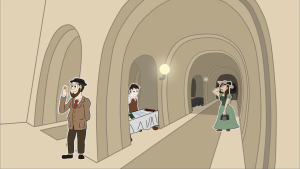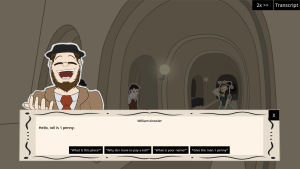
From 12 May to 25 June 2025, a team from Worcester Polytechnic Institute (WPI) in Massachusetts were at the Brunel Museum to work on a new project entitled ‘Designing a Multimedia Interactive View of the Thames Tunnel Bazaar’.
When the Thames Tunnel opened on 25 March 1843, it was more of a shopping centre than a method of crossing the river. Filled with shops selling all kinds of trinkets, souvenirs, food and other goods, the Tunnel was also the site of underwater carnivals, annual ‘Fancy Fairs’, and all kinds of amusements.
On display in the Museum are a number of objects, many kindly loaned by Sir William and Lady Judith McAlpine, which were once sold to visitors to the Thames Tunnel. From plates to glassware, peepshows to guidebooks, they give a sense of the range of goods on offer.
What about the people who sold these goods? In 2024, Jack Hayes (Collections Access Coordinator) developed a database of names of those who worked in the Tunnel, drawing notably on information gathered in contemporary newspaper and the court records of the Old Bailey.

L-R: Amelia Collard, Tyler Allison, Jack Hayes (Brunel Museum), Hung Dao, and Quinn Williams
The task for the WPI team was to bring this database to life in an interactive way, and enable people and visitors to ‘experience’ walking through the Thames Tunnel bazaar for themselves. The team visited other sites, including the National Maritime Museum and the Science Museum, to consider current gallery interactives; met with Andy Richardson (Head of Exhibition, Access, and Learning at the Postal Museum) and Anna Ravenscroft (Freelance Interpretation Consultant) to learn best practices for developing interactives; interviewed Brunel Museum staff and volunteers to identify their needs for an interactive; and developed a prototype of the Thames Tunnel digital interactive.
The team’s prototype digital interactive allows players to walk through the Thames Tunnel, meeting various individuals and purchasing objects of the kind once sold in the Tunnel. All the characters are based on real-life historic individuals, including:
-
- William Knowler, one of the Tunnel toll collectors
- Bondy Azulay, a stationer who sold objects including peepshows
- Samuel Bentall, who sold ‘fancy articles’
- Sarah Moss — who had a stall next to Bentall selling similar goods
The inclusion of Sarah Moss and Samuel Bentall allowed the team to even showcase a lively episode in the Tunnel history: when Sarah Moss complained that Bentall was smoking, it led to a physical fight under the Thames. The pair were later hauled before the courts, and both slapped with fines.

The team’s report is now available via the WPI London Project Centre website. They recommend the Museum continue to develop and use this interactive to enhance their engagement with younger audiences, increase accessibility to the Museum’s knowledge, and expand the educational resources the Museum offers. For future development, they also recommended the inclusion of more female characters to more accurately match the demographic of vendors in the Tunnel, and the inclusion of an achievement or goal system to encourage players to spend more time in the interactive.
